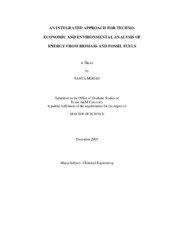| dc.description.abstract | Biomass conversion into forms of energy is receiving current attention because of environmental, energy and agricultural concerns. The purpose of this thesis is to analyze the environmental, energy, economic, and technological aspects of using a form of biomass, switchgrass (panicum virgatum), as a partial or complete replacement for coal in power generation and cogeneration systems. To examine the effects of such a substitution, an environmental biocomplexity approach is used, wherein the agricultural, technological, economic, and environmental factors are addressed. In particular, lifecycle analysis (LCA) and a three-dimensional integrated economic, energy and environmental analysis is employed. The effectiveness of alternate technologies for switchgrass preparation, harvest and use in terms of greenhouse gas impact, cost and environmental implications is examined. Also, different scenarios of cofiring and biomass preparation pathways are investigated. Optimization of the total biomass power generation cost with minimum greenhouse gas effect is undertaken using mathematical programming for various alternate competitive biomass processing pathways. As a byproduct of this work a generic tool to optimize the cost and greenhouse gas emissions for allocation of fuel sources to the power generating sinks is developed. Further, this work discusses the sensitivity of the findings to varied cofiring ratios, coal prices, hauling distances, per acre yields, etc. Besides electricity generation in power plants, another viable alternative for reducing greenhouse gases (GHGs) is the utilization of biomass in conjunction with combined heat and power (CHP) in the process industries. This work addresses the utilization of biowaste or biomass source in a processing facility for CHP. A systematic algebraic procedure for targeting cogeneration potential ahead of detailed power generation network design is presented. The approach presented here effectively utilizes the biomass and biowaste sources as external fuel, and matches it with the use and dispatch of fuel sources within the process, heating and non-heating steam demands, and power generation. The concept of extractable energy coupled with flow balance via cascade diagram has been used as a basis to construct this approach. The work also discusses important economic factors and environmental policies required for the cost-effective utilization of biomass for electricity generation and CHP. | en |


